Inca Art › Curses & Fines On Epitaphs » Ancient origins
Articles and Definitions › Contents
- Inca Art › Ancient History
- Curses & Fines On Epitaphs › Antique Origins
Ancient civilizations › Historical and archaeological sites
Inca Art › Ancient History
Definition and Origins
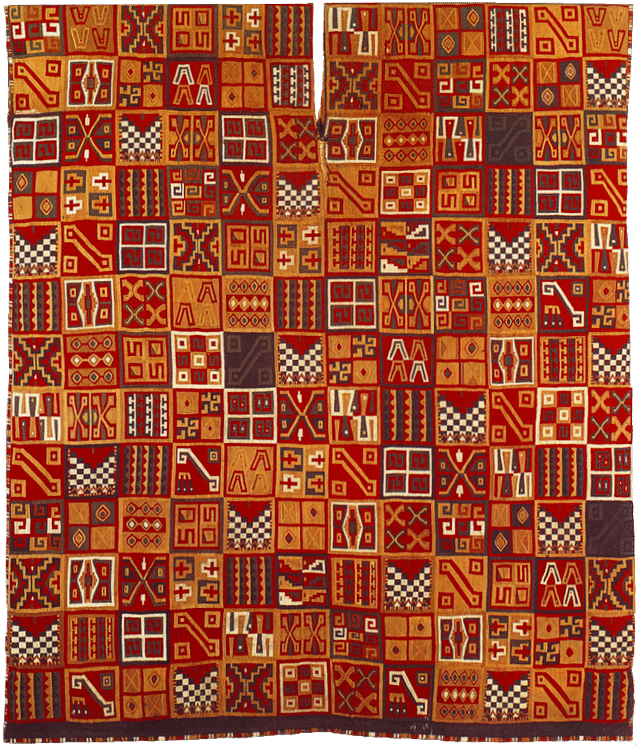
The art of the Inca civilization of Peru (c. 1425-1532 CE) produced some of the finest works ever crafted in the ancient Americas. Inca art is best seen in highly polished metalwork, ceramics, and, above all, textiles, with the last being considered the most prestigious by the Incas themselves. Designs often use geometrical shapes, are standardized, and technically accomplished. The European invaders destroyed much of Inca art either for sheer monetary gain or religious reasons but enough examples survive as testimony to the magnificent range and skills of Inca artists.
INFLUENCES & DESIGNS
Although influenced by the art and techniques of the earlier Chimu civilization, the Incas did create their own distinctive style which was an instantly recognisable symbol of imperial dominance across their massive empire. The Incas would go on to produce textiles, ceramics, and metal sculpture technically superior to any previous Andean culture, and this despite stiff competition from such masters of metalwork as the craftsmen of the Moche civilization.
Just as the Incas imposed a political dominance over their conquered subjects, so too with art, they imposed standard Inca forms and designs. The art itself did not suffer as a consequence, though. As art historian Rebecca Stone puts it,
Standardisation, though powerfully unifying, did not necessarily lower the quality of art; technically Inca tapestry, large-scale ceramic vessels, mortar-less masonry, and miniature metal sculptures are unsurpassed. ( Art of the Andes, 194)
The checkerboard stands out as a very popular design. One of the reasons for the repetition of designs was that pottery and textiles were often produced for the state as a tax, and so artworks were representative of specific communities and their cultural heritage. Just as today coins and stamps reflect a nation's history, so too, Andean artwork offered recognisable motifs which either represented the specific communities making them or the imposed designs of the ruling Inca class ordering them.The Incas did, though, allow local traditions to maintain their preferred colours and proportions. In addition, gifted artists such as those from Chan Chan or the Titicaca area and women particularly skilled at weaving were brought to Cuzco so that they could produce beautiful things for the Inca rulers.
ANDEAN ARTWORK OFFERED RECOGNISABLE MOTIFS WHICH REPRESENTED THE SPECIFIC COMMUNITIES MAKING THEM & THE IMPOSED DESIGNS OF THE RULING INCA CLASS ORDERING THEM.
It is also notable that both Inca pottery decoration and textiles did not include representations of themselves, their rituals, their military conquests, or such common Andean images as monsters and half-human, half-animal figures. Rather, the Incas almost always preferred colourful geometrical designs and abstract motifs representing animals and birds.
CERAMICS
Inca pottery used natural clay but added such materials as mica, sand, pulverised rock, and shell which prevented cracking during the firing process. There was no potter's wheel in the ancient Americas and so vessels were made by hand, first creating a base and then laying a coil of clay around it until the vessel reached the size required. Then the sides were smoothed using a flat stone. Smaller and medium-sized vessels were made using clay moulds. Before firing, a clay 'slip' was added and the vessel was painted, incised (sometimes using stamps), or had reliefs added. In kilns, pits, or open fires, the vessel was then fired using the oxidising method (adding oxygen to the flames) to create red, yellow and cream coloured pottery, or, via the reduction method (limiting the oxygen supply) to produce black wares.
Ceramics were for wider use, and so forms were, above all, practical. The most common shape was the urpu, a bulbous vessel used for storing maize with a long neck, flared lip, two small handles low on the pot, and a pointed base. The point at the base pressed into the ground and stabilised the pot while maize was poured into it. There were standardized sizes of urpubased on their content volume. They were decorated with abstract plant motifs and geometrical designs, most commonly zig-zags and dots. Examples from Cuzco are more elegant than those from other regions and are painted a distinctive black on red.

Inca Bird-handled Dish
Other types of ceramics are large flat serving dishes with animal figure handles, bowls, tall qeros beakers (made in pairs and also in wood), and the paccha. The latter was a hollow tube in the shape of a foot plough, typically decorated with three-dimensional additions such as a corn cob and urpu. The paccha (meaning 'waterfall') was placed into the ground so that maize beer could be ritually poured into it in ceremonies to promote a good harvest.
METALWORK
Objects using precious metals such as discs, jewellery, figurines, ceremonial knives ( tumi ), lime dippers, and everyday objects were made exclusively for Inca nobles. Gold was considered the sweat of the sun, and silver was considered the tears of the moon. Copper was another popular material, and these metals would have been inlaid with precious stones such as emeralds, polished semi-precious stones like lapis lazuli, polished bone, and spondylus shell. Alternatively, gold and silver were inlaid into bronze. Metals were alloyed, cast, beaten, incised, embossed, beaded, and used as gilding. Inca jewellery pieces made from precious metals included earrings, earspools, pendants, bracelets, and dress pins.
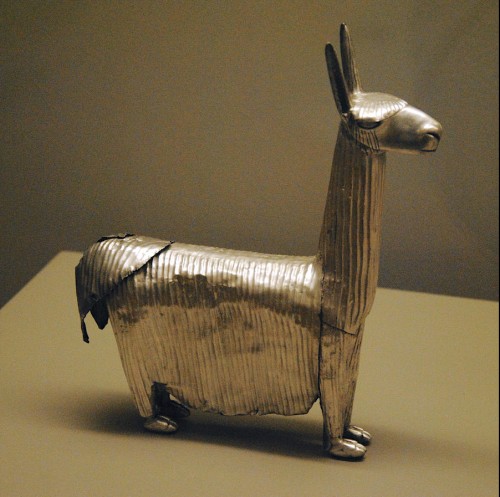
Inca Silver Alpaca
The Inca royalty only drank from gold and silver beakers, and their shoes had silver soles. Surviving figurines, both of humans and llamas, found in burial sites were made either by cast or with up to 18 separate sheets of gold and carved in intricate life-like detail. Gold and silver were also used for many religious pieces, especially representations of natural phenomena and places the Incas held sacred. These works represented the sun, moon, stars, rainbows, lightning, waterfalls, and so on. Masks representing the principal gods such as Inti the god of the sun and Mama Kilya the goddess of the moon, along with other sacred objects, were then placed within Inca temples but these have since been lost.
Perhaps the most famously lost Inca art piece is a gold statue of Inti, represented as a small seated boy and known as Punchao, which was kept in the Temple of the Sun, at the Coricancha ( Qorikancha ) sacred complex at Cuzco. With rays projecting from his head and decorated with gold jewellery, the stomach of this figure was used as a receptacle for the ashes of the burned vital organs of previous Inca kings. Each day the statue was brought outside of the temple to bask in the sun.Following the Spanish conquest the figure was removed and hidden, never to be found again.
The Coricancha also had a stunning garden dedicated to Inti. Everything in it was made of gold and silver. A large field of corn and life-size models of shepherds, llamas, jaguars, guinea pigs, monkeys, birds and even butterflies and insects were all crafted in precious metal. All that survives of these wonders are a few golden corn stalks, a convincing, if silent, testimony to the lost treasures of Inca metalworkers.
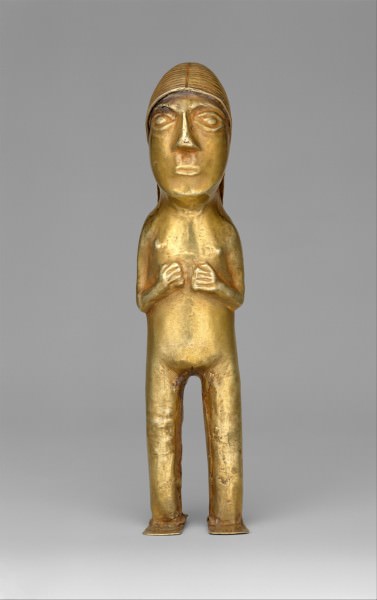
Inca Gold Female Figurine
TEXTILES
Although very few examples of Inca textiles survive from the heartland of the empire, we do have, thanks to the dryness of the Andean environment, many textile examples from the highlands and mountain burial sites. In addition, Spanish chroniclers often made drawings of textile designs and clothing so that we have a reasonable picture of the varieties in use. Consequently, we have many more examples of textiles than other crafts such as ceramics and metalwork.
For the Incas, finely worked and highly decorative textiles came to symbolize both wealth and status. Fine cloth could be used as both a tax and currency, and the very best textiles became amongst the most prized of all possessions, even more precious than gold or silver. Inca weavers were technically the most accomplished the Americas had ever seen and, with up to 120 wefts per centimetre, the best fabrics were considered the most precious gifts of all. As a result, when the Spanish arrived in the early 16th century CE, it was textiles and not metal goods which were given in welcome to these visitors from another world.
It seems that both men and women created textiles, but it was a skill women of all classes were expected to be accomplished at. At the capital Cuzco, the finest cloth was made by male specialists known as qumpicamayocs or 'keepers of the fine cloth'.The principal equipment was the backstrap loom for smaller pieces and either the horizontal single-heddle loom or vertical loom with four poles for larger pieces. Spinning was done with a drop spindle, typically in ceramic or wood. Inca textiles were made using cotton (especially on the coast and in the eastern lowlands) or llama, alpaca, and vicuña wool (more common in the highlands) which can be exceptionally fine. Goods made using the super-soft vicuña wool were restricted and only the Inca ruler could own vicuña herds. Rougher textiles were also made using maguey fibres.
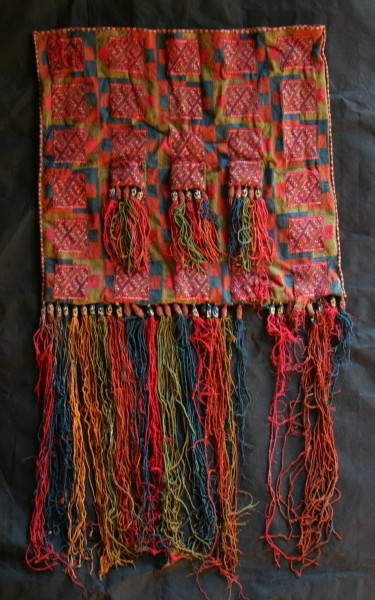
Inca Textile Bag
The principal colours used in Inca textiles were black, white, green, yellow, orange, purple, and red. These colours came from natural dyes which were extracted from plants, minerals, insects, and molluscs. Colours also had specific associations. For example, red was equated with conquest, rulership, and blood. This was most clearly seen in the Mascaypacha, the Inca state insignia, where each thread of its red tassel symbolised a conquered people. Green represented rainforests, the peoples who inhabited them, ancestors, rain and its consequent agricultural growth, coca, and tobacco. Black signified creation and death, while yellow could signal maize or gold. Purple was, as in the rainbow, considered the first colour and associated with Mama Oclla, the founding mother of the Inca race.
Besides using dyed strands to weave patterns, other techniques included embroidery, tapestry, mixing different layers of cloth, and painting – either by hand or using wooden stamps. The Incas favoured abstract geometric designs, especially checkerboard motifs, which repeated patterns ( tocapus ) across the surface of the cloth. Certain patterns may also have been ideograms. Non-geometrical subjects, often rendered in abstract form, included felines (especially jaguars and pumas), llamas, snakes, birds, sea creatures, and plants. Clothes were simply patterned, commonly with square designs at the waist and fringes and a triangle marking the neck. One such design was the standard military tunic which consisted of a black and white checkerboard design with an inverted red triangle at the neck.
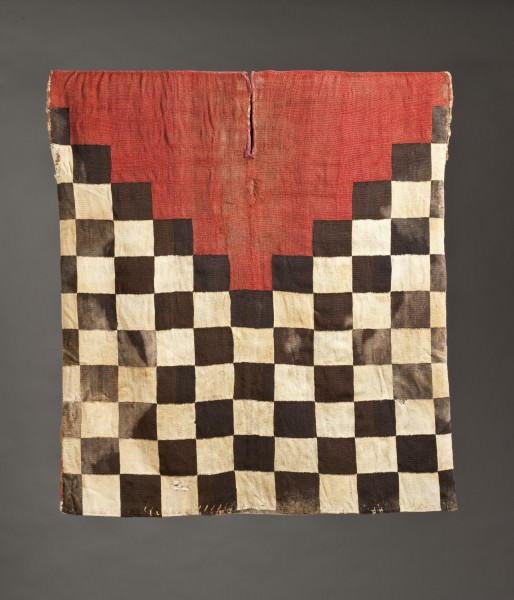
Inca Military Tunic
Additional decoration could be added to textile articles in the form of tassels, brocade, feathers, and beads of precious metal or shell. Precious metal threads could also be woven into the cloth itself. As feathers were usually from rare tropical birds and condors, these garments were reserved for the royal family and nobility.
CONCLUSION
The European invaders in the 16th century CE not only ruthlessly melted down or spirited away any precious Inca goods they found but also attempted to repress elements of Inca art, even banning such trivial objects as the qeros beakers in an attempt to curb drinking habits. Distinctive Inca textile designs such as those connected to royal power were also discouraged but, in defiance, many of the indigenous peoples continued with their artistic traditions. Thanks to this perseverance and continuity, and despite an evolution where designs were blended with elements of colonial art, many traditional Inca designs and motifs survive to this day and are celebrated as such in the ceramics, metalwork, and textiles of modern Peru.
Curses & Fines On Epitaphs › Antique Origins
Ancient Civilizations
In antiquity, apart from thieves, tombs were also damaged by people of low economic status. While thieves damaged tombs for burial gifts and the clothing of the dead, some people opened tombs of strangers to bury members of their own families or dismantled them in order to use pieces to make a new tomb. Grave monuments were also damaged to make milestones and to use in constructing walls, especially in late antiquity. There were two ways in antiquity to prevent violations of graves: fining and cursing.
To discourage people from violating tombs, fines were determined to be paid to the treasury of the city. To enhance the discouragement, the amount would be high, and it was legally determined to pay a part of it to the informer who reported the culprit to the authorities.
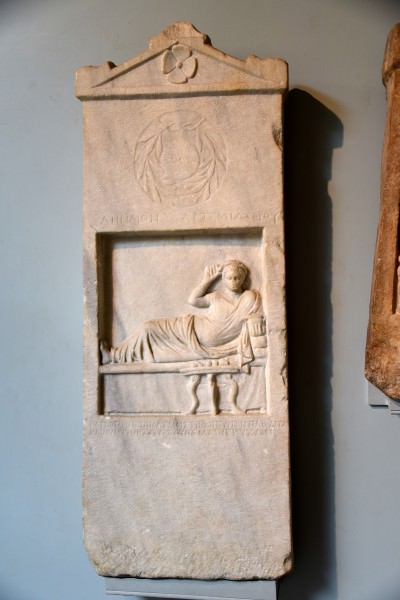
Grave Stela of Lenaios
On the other hand, curses were common maledictions used by the public, addressing the person with the potential of damaging the tomb and warning the violator of the misfortunes that would happen to him. These curses were added to the end of the grave inscriptions by the owner of the tomb. Protecting graves via curses has a long history in the Near East and Anatolia. According to the religious beliefs of Anatolians on death and the afterlife, the body of the dead person that has said goodbye to this world physically continued to live in the other world, and for his feelings and desires which continue also in this afterlife he needs a refuge that he would not want to share with others.
In the curses it is wished that the wrath of the gods should be directed onto the violator through disasters such as painful or untimely death, living pain because of family perishing, the house perishing as a result of fire, the children becoming orphans, epidemics, blindness, becoming disabled, etc. The power of the mechanism of punishment that starts after the violation is committed is hidden in the words incised on the grave monument.
Inv. 1225 T from the Istanbul Archaeological Museums reads:
Nicephoros, son of Moschion (made) (this grave) for his wife Glyconis and in his own memory while still alive: if anyone buries another body (here) without my permission, he will pay 2500 denarii to the city and will be responsible for the crime of grave robbery.
(GRAVE STELE OF NICEPHOROS AND GLYCONIS, Marble, Conane (Gonen, Bahkesir), Roman Period, end of 2nd, beginning of 3rd C CE)
When we geographically proportion the grave inscriptions with curses, it is observed that the majority are from Phrygia, especially in the provincial areas of the region, where Phrygians, who had been away from the influence of Hellenization, lived.Comparing Phrygia with the other areas of Anatolia, it is observed that such curses diminish in number in those areas.
As a result of the hardships felt in the lives of the public through the crises of the 3rd century CE and in relation with the decrease in the trust for the establishment of justice because of these crises, especially effected Anatolian villages had an increased need for grave curses under this negative socio-economic condition. It is observed that curses on the grave stelae and sarcophagi with rich and large decorations were mostly used by people who had affluence in society, especially Roman citizens. Rather insignificant in number, there are also a few examples belonging to slaves and intellectuals. Such protective precautions of pagan origin have also been adopted by Christian and Jewish communities and found place on their grave stelae as well.
LICENSE:
Article based on information obtained from these sources:with permission from the Website Ancient History Encyclopedia
Content is available under License Creative Commons: Attribution-NonCommercial-ShareAlike 3.0 Unported. CC-BY-NC-SA License